| enter keyword to search: |
|
Images db
|
|
|
Articles db
|
|
|
|
|
|
|
| Udayagiri, Ratnagiri and Lalitgiri |
|
Hidden away in the well-watered backcountry south of the River Brahmani, 65 km northeast of Cuttack, lie the remains of three ancient Buddhist universities, forming the triangle of Udayagiri, Ratnagiri and Lalitgiri, the monasteries that flourished between the 7th and the 12th centuries A.D.
Udayagiri |
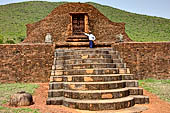
|
Udayagiri
The most recently discovered of the three sites, Udayagiri (Sri Madhavapura-mahavihara), is the largest Buddhist Complex in Orissa. The entire area is located at the foothills of a hill that acts as an imposing backdrop. At the base of the hill there is a rock-cut well (xi c. AD), with a long flight of steps leading down to the water.
Along the path leading from the ancient well to the stupa, two broken images are still in situ both representing a four-armed Avalokitesvara (viii c) with a hand in the varada mudra and holding a rosary and a lotus. On the airdo of one of them we noted an effigy of Amitabha. Most images of Buddhist deities are stereotyped in Avalokitesvara or Lokesvara and Tara.
The large brick stupa, better preserved than its counterpart at Ratnagiri, is built on a natural terrace with a square base. All four directional Buddhas are inside niches: Aksioba on the east, Ratnasambhava on the south, Amitabha on the west, on the north Amoghasiddhi in a monastic dress. Each figure is flanked by a pair of Bodhisattvas and all date to the viii c.
Further on, the remains of the large monastic complex (viii c AD). Around a vast open courtyard there are the cells for monks and a central shrine housing a colossal image of a seated Buddha in a bhumisparsa-mudra and a ruined vairocana mandala. The doorframe of the sanctum is richly carved (viii c). The decorations here are very similar to those at nearby Ratnagiri: acrobats climbing foliage and miniaturized dvarapalas.
In the southern half of the valley named Udayagiri-2 the excavation had partially revealed a double storied monastic complex datable to 8th Cent. A.D. and other minor stupas and statues.
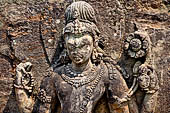
|
Udayagiri
|
Ratnagiri
(Sri Ratnagiri-mahavihara) On the top of a hill overlooking the River Keluo, Ratnagiri since Gupta times (v c A.D.) was an important Mahayana centre and, evidenced by the numerous reliefs of Vajrayana divinities, it became a centre of Tantric Buddhism. From the site entrance a path leads up hill climbing the gardened slope reaching the remains of two monasteries, further on, on the hill top, a stupa surrounded by a number of smaller ones. Particularly important for the iconography are the more than the seven hundred portable monolithic stupas (ix-xiii c.), an overwhelming number of which present niches housing images of Mahayana and Vajrayana deities.
Ratnagiri |
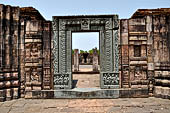
|
The Monastery n° 1 the ‘Mahavihara’ (vii c), the larger of the two monasteries, is the one with the famous beautiful carved doorway.
The monastery is on a platform and it is accessed with a stairway. The niche at the right of the entrance still has a beautiful khondolite image of a standing Tara accompanied by flying celestials (top) and ascetics carrying water pots (middle), her right hand extends in varada mudra, the gesture of giving. The niche on the other side is empty.
Inside the entrance porch one can admire the beautiful carved doorway of two different stone, as shown by their contrasting colours: chlorite (green) and khondalite (brownish).
On the west wall of the entrance porch there are two carved stone slab. In one there is the image of Avalokiteshvara (ix C) with, sitting at his feet, his usual companions: Tara and Brikuti, each with four arms, and his wrathful attendant Hayagriva. The slab nearby has a headless image of Avalokiteshvara, her right hand in varada mudra, while a lotus flower curls above her left shoulder, at the base a seated two-armed Tara.
On the east wall of the entrance porch, inside a niche, there is a khondolite image of Vajrapani, with a wrathful attendant at his feet. In the opposite niche of the porch west wall there is an image of Avalokiteshvara also with a wrathful attendant at his feet.
South inner wall and entrance the Hindu / Buddhist prosperity motifs of River Yamuna, Gajalakshmi, Kubera / Panchika. The River Yamuna goddess brings fertile soil and fish; Kubera is a yaksha (nature-spirit), the guardian of buried treasure, as indicated by the pots beneath his throne; and Lakshmi is the goddess of wealth, symbolizing the life-giving monsoon (elephants = storm clouds). In Buddhist symbolism Gajalakshmi is also understood as representing the birth of the Buddha.
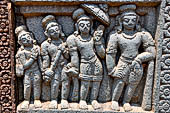
|
Ratnagiri
|
Having passed the entrance porch you will find yourself into the large courtyard of the monastery surrounded by the monks' cells. Dotted around a rich array of carvings and innumerable stone sculptures still in situ of the Mahayana and Vajrayana deities, bodhisattvas, female deities and piles of fallen masonry. Along the edge of the courtyard an imposing head of Buddha. Along the western side the reconstructed external façade, with deep cell-like niches, that used to be erected in front of the shrine.
On the north side of the courtyard the main shrine. The frame of the entrance doorway is carved from several blocks of stone with lively acrobatic figures swinging on the foliage. Inside, the shrine contains the Shakyamuni Triad (viii c): Shakyamuni Buddha, in bhumisparsha mudra, flanked by Avalokiteshvara and Vajrapani. In their right hands, each bodhisattva holds a chauri (fan).
Ratnagiri |
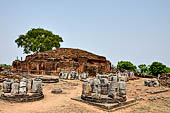
|
Lalitgiri
The ruins of LALITGIRI (ninth century) are on a hill. The best of the sculpture has been placed in the small museum and only some chunks are still lying around the place. At the top of the hill above the museum the large stupa affords a splendid view across the lush green paddy fields of the plain below. The majestic ruins of the huge brick monastery, the remains of the chaitya hall, a number of votive stupas.
The museum displays a large number of Mahayana sculptures consisting of colossal Buddha figures, huge Boddhisattva statues, statues of Tara, Jambhala and others.
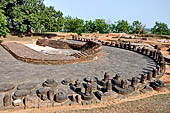
|
Lalitgiri
|
|
|
|
|
 |
|
|



